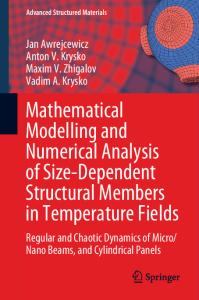Thermoelastic Stress Analysis
In this chapter an outline of the theoretical foundations for the experimental technique of thermoelastic stress analysis is presented, followed by a description of the equipment, test materials, and methods required to perform an analysis. Thermoelastic
- PDF / 1,650,045 Bytes
- 25 Pages / 547.087 x 685.984 pts Page_size
- 69 Downloads / 371 Views
Richard J. Greene, Eann A. Patterson, Robert E. Rowlands
In this chapter an outline of the theoretical foundations for the experimental technique of thermoelastic stress analysis is presented, followed by a description of the equipment, test materials, and methods required to perform an analysis. Thermoelastic stress analysis is a technique by which maps of a linear combination of the in-plane surface stresses of a component are obtained by measuring the surface temperature changes induced by time-varying stress/strain distributions using a sensitive infrared detector. Experimental considerations relating to issues such as shielding from background radiation, edge effects, motion compensation, detector setup, calibration, and data interpretation are discussed. The potential of the technique is illustrated using a number of examples that involve isotropic as well as orthotropic materials, fracture mechanics, separation of component stresses, and vibration analysis. Applications of the method to situations involving residual stresses, elevated temperatures, and variable amplitude loading are also considered.
26.1 History and Theoretical Foundations ...... 744
26.4 Calibration ........................................... 749 26.5 Experimental Considerations ................. 26.5.1 Background Infrared Radiation Shielding .................................. 26.5.2 Edge Effects and Motion Compensation .......... 26.5.3 Specimen Preparation................. 26.5.4 Reference Signal Requirements .... 26.5.5 Infrared Image Setup .................. 26.5.6 Adiabaticity ............................... 26.5.7 Thermoelastic Data Format .......... 26.5.8 Data Processing..........................
749
750 751 751 751 752 752 752
26.6 Applications ......................................... 26.6.1 Isotropic Structural Materials ....... 26.6.2 Orthotropic Materials .................. 26.6.3 Fracture Mechanics..................... 26.6.4 Experimental Stress Separation .... 26.6.5 Residual Stress Measurement....... 26.6.6 Vibration Analysis ...................... 26.6.7 Elevated Temperature Analysis..... 26.6.8 Variable-Amplitude Loading........
753 753 753 755 756 757 757 758 759
749
26.7 Summary ............................................. 759 26.A Analytical Foundation of Thermoelastic Stress Analysis ............. 760
26.2 Equipment ........................................... 745
26.B List of Symbols ..................................... 762
26.3 Test Materials and Methods ................... 747
References .................................................. 763
Thermoelastic stress analysis (TSA) is an emerging technique that to date has been used successfully for the evaluation and validation of design concepts, fracture mechanics, damage detection, fatigue monitoring, and residual stress analysis. Maps of surface stress are obtained in real time by measuring the temperature changes induced by time-varying stress/strain distributions. Under adiabatic and reversible conditions, a cyclically loaded structure experiences i
Data Loading...











